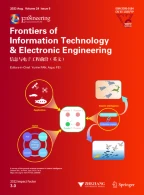Abstract
This paper discusses transmission performance and power allocation strategies in an underlay cognitive radio (CR) network that contains relay and massive multi-input multi-output (MIMO). The downlink transmission performance of a relay-aided massive MIMO network without CR is derived. By using the power distribution criteria, the kth user’s asymptotic signal to interference and noise ratio (SINR) is independent of fast fading. When the ratio between the base station (BS) antennas and the relay antennas becomes large enough, the transmission performance of the whole system is independent of BS-to-relay channel parameters and relates only to the relay-to-users stage. Then cognitive transmission performances of primary users (PUs) and secondary users (SUs) in an underlay CR network with massive MIMO are derived under perfect and imperfect channel state information (CSI), including the end-to-end SINR and achievable sum rate. When the numbers of primary base station (PBS) antennas, secondary base station (SBS) antennas, and relay antennas become infinite, the asymptotic SINR of the kth PU and SU is independent of fast fading. The interference between the primary network and secondary network can be canceled asymptotically. Transmission performance does not include the interference temperature. The secondary network can use its peak power to transmit signals without causing any interference to the primary network. Interestingly, when the antenna ratio becomes large enough, the asymptotic sum rate equals half of the rate of a single-hop single-antenna K-user system without fast fading. Next, the PUs’ utility function is defined. The optimal relay power is derived to maximize the utility function. The numerical results verify our analysis. The relationships between the transmission rate and the antenna number, relay power, and antenna ratio are simulated. We show that the massive MIMO with linear pre-coding can mitigate asymptotically the interference in a multi-user underlay CR network. The primary and secondary networks can operate independently.
Similar content being viewed by others
References
Amarasuriya G, Poor HV, 2015. Multi-user relay networks with massive MIMO. IEEE Int Conf on Communications, p.2017–2023. https://doi.org/10.1109/ICC.2015.7248622
Boccardi F, Heath R, Lozano A, et al., 2014. Five disruptive technology directions for 5G. IEEE Commun Mag, 52(2):74–80. https://doi.org/10.1109/MCOM.2014.6736746
Chen C, Wang L, 2007. Performance analysis of scheduling in multiuser MIMO systems with zero-forcing receivers. IEEE J Sel Area Commun, 25(7):1435–1445. https://doi.org/10.1109/JSAC.2007.070916
Goldsmith A, Jafar S, Maric I, et al., 2009. Breaking spectrum gridlock with cognitive radios: an information theoretic perspective. Proc IEEE, 97(5):894–914. https://doi.org/10.1109/JPROC.2009.2015717
Haykin S, 2005. Cognitive radio: brain-empowered wireless communications. IEEE J Sel Area Commun, 23(2):201–220. https://doi.org/10.1109/JSAC.2004.839380
Hosseini K, Hoydis J, Ten Brink S, et al., 2013. Massive MIMO and small cells: how to densify heterogeneous networks. IEEE Int Conf on Communications, p.5442–5447. https://doi.org/10.1109/ICC.2013.6655455
Li JZ,Ai Bo, He RS, et al., 2017. Indoor massive multipleinput multiple-output channel characterization and performance evaluation. Front Inform Technol Electron Eng, 18(6):773–787. https://doi.org/10.1631/FITEE.1700021
Li Y, Zhu G, Du X, 2014. Aligning guard zones of massive MIMO in cognitive femtocell networks. IEEE Commun Lett, 18(2):229–232. https://doi.org/10.1109/LCOMM.2013.123113.131913
Manna R, Louie R, Li Y, et al., 2011. Cooperative spectrum sharing in cognitive radio networks with multiple antennas. IEEE Trans Signal Process, 59(11):5509–5522. https://doi.org/doi:10.1109/TSP.2011.2163068
Marzetta T, 2010. Noncooperative cellular wireless with unlimited numbers of base station antennas. IEEE Trans Wirel Commun, 9(11):3590–3600. https://doi.org/10.1109/TWC.2010.092810.091092
Mitola J, Maguire G, 1999. Cognitive radio: making software radios more personal. IEEE Pers Commun, 6(4):13–18. https://doi.org/10.1109/98.788210
Ngo H, Larsson E, Marzetta T, 2013. Energy and spectral efficiency of very large multiuser MIMO systems. IEEE Trans Commun, 61(4):1436–1449. https://doi.org/10.1109/TCOMM.2013.020413.110848
Rusek F, Persson D, Lau BK, et al., 2013. Scaling up MIMO: opportunities and challenges with very large arrays. IEEE Trans Signal Process Mag, 30(1):40–60. https://doi.org/10.1109/MSP.2011.2178495
Suraweera H, Ngo H, Duong T, et al., 2013. Multi-pair amplify-and-forward relaying with very large antenna arrays. IEEE Int Conf on Communications, p.4635–4640. https://doi.org/10.1109/ICC.2013.6655302
Tao YZ, Wu CY, Huang YZ, et al., 2018. A projected gradient based game theoretic approach for multi-user power control in cognitive radio network. Front Inform Technol Electron Eng, 19(3):367–378. https://doi.org/10.1631/FITEE.1700067
Wang L, Ngo H, Elkashlan M, et al., 2017. Massive MIMO in spectrum sharing networks: achievable rate and power efficiency. IEEE Syst J, 11(1):20–31. https://doi.org/10.1109/JSYST.2015.2449289
Zhang Q, Jin S, McKay M, et al., 2015. Power allocation schemes for multicell massive MIMO systems. IEEE Trans Wirel Commun, 14(11):5941–5955. https://doi.org/10.1109/TWC.2015.2444856
Author information
Authors and Affiliations
Corresponding author
Additional information
Project supported by the National Natural Science Foundation of China (Nos. 61227801 and 61629101), the Huawei Communications Technology Lab, the Open Research Foundation of Xi’an Jiaotong University (No. sklms2015015), and the China Scholarship Council (CSC)
Rights and permissions
About this article
Cite this article
Liu, S., Ahmad, I., Zhang, P. et al. Multi-user rate and power analysis in a cognitive radio network with massive multi-input multi-output. Frontiers Inf Technol Electronic Eng 19, 674–684 (2018). https://doi.org/10.1631/FITEE.1700081
Received:
Accepted:
Published:
Issue Date:
DOI: https://doi.org/10.1631/FITEE.1700081
